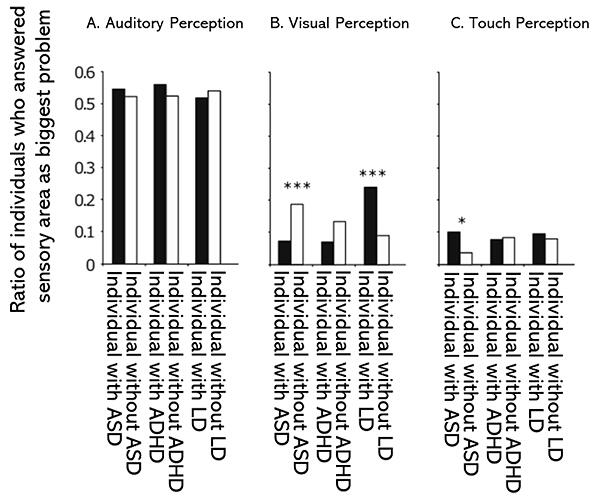A research group consisting of Section Chief Makoto Wada of the Developmental Disorders Section, Dept. of Rehabilitation for Brain Functions, Research Institute (RI) of National Rehabilitation Center for Persons with Disabilities (NRCD) and his colleagues has announced that they have surveyed the characteristics of sensory issues in developmental disorders (autism spectrum disorder (ASD), attention‐deficit/hyperactivity disorder (ADHD), and learning disorders (LD)), clarifying that while the most obvious common issues are auditory, the sense of touch is also a major issue in ASD. The group created a questionnaire that asked about sensory issues that occur in everyday life, aimed at people who have been diagnosed with a developmental disorder. They called for participants online, obtained 431 responses from a wide range of ages and collated the data. They found that there are significant individual differences when it comes to sensory issues in people with developmental disorders. It is hoped that this will lead to appropriate support. Their results were published in the 09 February 2023 edition of the international academic journal Frontiers in Psychiatry.

Provided by the National Rehabilitation Center for Persons with Disabilities
It is known that people with developmental disorders have various sensory difficulties. The main characteristics of dysfunction in ASD are issues with socialization and communication, repetitive behavior and limited interests, but the American Psychiatric Association's Diagnostic and Statistical Manual of Mental Disorders, Fifth Edition (DSM‐5) also reports occurrences of sensory issues, such as hypersensitivity and hyposensitivity. A variety of different sensory issues in ADHD and LD are also reported. However, the differences in these characteristic dysfunctions are unclear and so are not linked to appropriate support.
Thus, this research group carried out a survey aiming to 'visualize' what people who have been diagnosed with a developmental disorder find difficult on a day‐to‐day basis in relation to their senses. More specifically, they created a questionnaire that combined multiple choice and free writing to clarify what sort of sensory issues occur during the respondent's everyday life. The questionnaire items were planned with the cooperation of a volunteer study group on developmental disorders, in which individuals with ASD/ADHD/LD, people in the medical field, researchers and administrative officers participated. The RI's Information and Support Center for Persons with Developmental Disorders accepted responses on its website from August 2018 to January 2019.
In so doing, it was able to obtain 431 responses from a wide age range, from preschool children (responses given by their guardians) to people in their 60s. The group excluded 16 of these, which described issues other than sensory issues, and compiled and analyzed the content of 415 responses. The respondents included people with (or suspected to have) ASD, ADHD, LD, intellectual disabilities, and other developmental disorders.
The results showed that around 55% of all respondents said that auditory problems are the 'most distressing sensory issue,' with around 10% of respondents saying this for vision, touch and smell, respectively. On the other hand, when it came to the second and third most distressing issues, responses concerning vision, touch, smell and issues associated with other senses increased, with 15%‐20% of responses for each.
Next, the group investigated whether there were differences in the occurrence and frequency of the sense that respondents selected as the most distressing issue based on each type of disorder (ASD, ADHD or LD). From this, they found that auditory issues occur in around 50% of people in all these disorders. On the other hand, tactile stimulation was significantly more distressing among people with ASD compared to those without, and visual stimulation was significantly more distressing among people with LD compared to those without. There were no significant differences based on disorder when it came to the second and third most distressing sensory issues.
Furthermore, when the group separated and analyzed the responses by age, they found significantly more descriptions of taste among minors (under 18 years), and significantly less among people of middle age (30‐49 years).
When classifying the issues described for each sense in the free writing sections, the group split them into two types of problem for hearing, vision, and smell: aversions to strong and/or specific stimuli, and confusion or pain regarding multiple stimuli presenting concurrently.
Based on these surveys, the researchers learned that sensory issues among people with developmental disorders do not just consist of feeling pain from stimuli associated with hearing or vision, as is conventionally thought; there are also people who find other senses the most painful, and the specifics of that pain are varied. This has clarified that responses to individual characteristics are needed.
Wada commented, "The questionnaire also asked for descriptions of the respondent's self‐coping. In a subsequent survey, we learned that while issues, such as dazzling lights and loud noises being problematic can be handled with sunglasses and earplugs, it is difficult to cope with individual sensory issues, such as finding it difficult to listen to people speaking. Now, we have identified issues for which self‐coping is tricky and are considering how we can deal with such problems."
This article has been translated by JST with permission from The Science News Ltd. (https://sci-news.co.jp/). Unauthorized reproduction of the article and photographs is prohibited.




